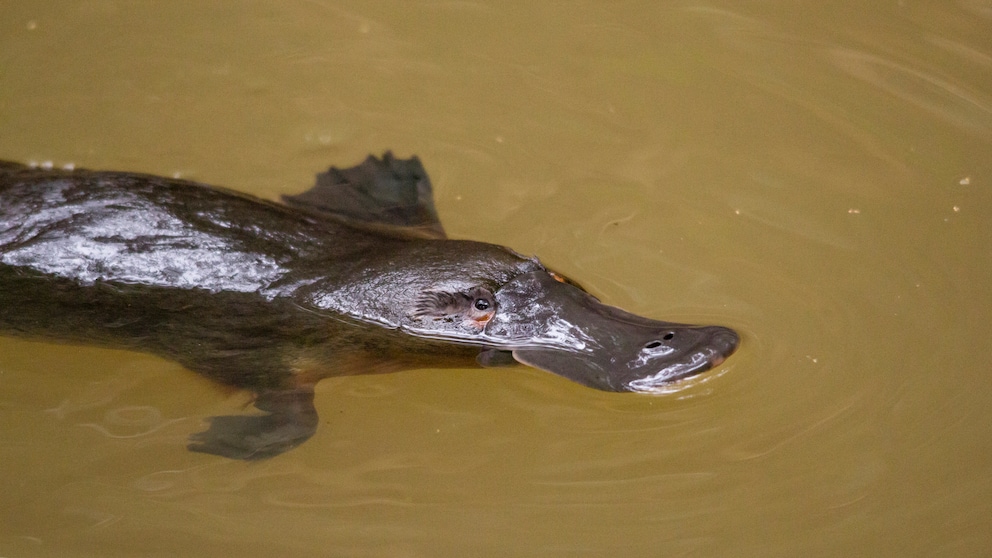June 20, 2024, 9:14 am | Read time: 4 minutes
Most people know that platypuses are one of the few egg-laying mammals. But hardly anyone knows that they are also highly poisonous. PETBOOK explains why these unusual inhabitants of Australia may also be dangerous to humans.
Australia is known for its unusual wildlife: Koalas, kangaroos and wombats populate the red continent. But there is another mammal that stands out from the rest: the platypus. The Australians even pay tribute to the platypus by featuring it on their 20-cent coin. As the name suggests, the platypus has a large beak, but also water-repellent fur. A beaver-like tail and webbed feet between their individual toes ensure greater mobility in the water.
The genetic material of this Australian animal also has special features: it shows that platypuses are categorized as a mammal as well as a bird and reptile. However, from a purely biological standpoint, platypuses are classified as monotremes, a group that includes only one other member: the echidna. All monotremes share the unique characteristic of laying eggs rather than giving birth to live young. However, platypuses differ from other cloacal animals and mammals in another respect: They are highly venomous.
Platypuses are among the most poisonous mammals in the world
As ponderous and cute as these strange animals may seem at first glance, platypuses can defend themselves very effectively. Males have an effective weapon to defend themselves against other platypuses or predators such as birds of prey or dingoes: “venomous spurs” about 15 millimeters long, which are located on their hind legs. These are hollow and contain an effective poison that platypuses produce in glands in their abdomen. If a platypus feels threatened, it can also use the venomous spurs in combat.
Although this venom is not fatal in humans, it causes extremely painful swelling that can last for months. Even highly effective painkillers are of little help against the suffering that a platypus bite can cause. It has been known since the time of platypus hunting in the 19th and 20th centuries that some hunting dogs also died from the venom of the platypus. This occurred when the dogs tried to return the killed but still defensible prey to their masters.

The Most Poisonous Animals in the World

Is There a Difference Between a Tarantula and a Bird Spider?

The most dangerous animals in Europe
What to do in the event of a platypus encounter
If you are worried about being poisoned by a platypus on a trip to Australia, you should be more concerned about the numerous, highly venomous snakes and spiders that you may encounter in the city during the day. Australia is the country and continent with the most venomous animals in the world, including the Sydney funnel web spider.
Platypuses, on the other hand, generally live very secluded lives in sparsely populated areas and are also nocturnal. They inhabit the damp banks of rivers and lakes, as well as the bodies of water themselves. They are also very shy animals that usually avoid people. So if you are not deliberately stalking a platypus, you probably don’t need to be afraid of a platypus bite. Researchers also believe that the venomous spurs evolved to help males drive rivals out of their territory. This is likely because the concentration of venom in the spurs is especially high during the mating season of these egg-laying mammals. Additionally, Australia offers numerous wildlife parks where platypuses can be observed in safe, simulated natural habitats.
In general, the same applies to platypuses as to all wild animals:
- Platypuses should not be disturbed in their natural habitat – neither by intrusion into their territory nor by the making of loud noises.
- If you happen to come across a platypus, keep calm and slowly increase your distance from them. From there, you can observe these special animals at a safe range.
- On land, platypuses are rather sluggish and slow-moving, which means humans have the advantage but should still move away quickly and quietly. In the water, however, platypuses can reach speeds of up to 35 km/h, making them aquatically superior to humans. If you come across a platypus swimming, it is best to return to the shore.

